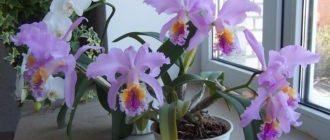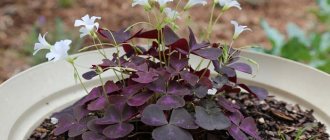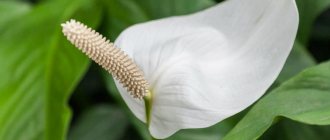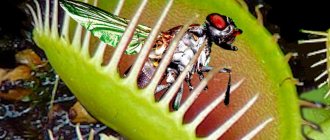In this article we will look at interesting facts about such an aristocratic flower as Clivia. It is worth noting that Clivia has many varieties, but they all have one interesting feature - the absence of a stem, but there are dense leaves collected in a rosette at the base, which change their color depending on the age of the flower.
Based on the mystical side of our existence, we will find out how this perennial plant can be useful in life, how it affects a person’s energy, what upcoming events can characterize the period of its flowering, what it will protect from and for whom it will be a talisman.
General description of clivia
The leaves are herbaceous with a thickened base, collected in a rosette. The flowers are red, yellow or orange, arranged several times in large inflorescences. They bloom twice a year. The first flowering is in February or the first ten days of March, the second in late May-early June. The roots are thick and strong, capable of accumulating moisture and nutrients.
The plant is considered unpretentious; it can be placed on any windows in the house. Of all the varieties, Clivia miniata and Clivia nobilis are cultivated. The first is used medicinally by the Zulu as an antidote for snake bites and a remedy for fever. At the same time, experts warn that the roots of the flower are toxic due to the presence of alkaloids, so they must be used in treatment with caution.
Feng Shui
According to the science of Feng Shui, the Kaffir lily embodies the active solar energy of Yang. This must be taken into account in order to maintain the balance of energy in the room.
This flower helps to activate the fire zone, so it is often placed in the south. It promotes self-realization, good study, development of talents, skills and gifts. Gives the necessary perseverance and determination to achieve success in your chosen business.
However, if the fire element predominates in the house (many corresponding symbols, objects, red shades, etc.), it is undesirable to add this plant as well.
Excessive strengthening can escalate the situation and create the ground for intolerance and conflicts. A good place for the kaffir lily is the southeast or wealth zone.
The flower activates monetary energy, accelerates the flow of income, and helps you see new options for earning money. In addition, clivia can be placed in the northwest - in the travel sector: you will very quickly have additional opportunities for trips and business trips.
Types of clivia
Five species of clivia are found in the wild; several more have been bred from them through selection:
- Clivia miniata (cinnabar) is the most common variety; one pedicel can contain from 15 to 20 orange-red inflorescences; peak flowering is February - March.
- White - leaves are fleshy, belt-type, white bell-shaped flowers are collected in inflorescences of 20 pieces. Blooms in early spring.
- Yellow - on an elongated peduncle there are several yellow umbrella flowers, belt-shaped leaf plates, the peduncle opens in mid-spring.
All three species reach a height of 70 cm. In addition to these crops, there are also the following varieties
| Type, description | Inflorescences | Leaves | Flowering time |
| Noble - bred in the Old World back in 1828. Plant length - 30 cm. | On a half-meter peduncle there are up to 60 tubular-dropping orange inflorescences. | Ensiform dark green. | Second half of February. |
| Nobilis (nobilis) is the birthplace of the plant in the Cape Province of the Republic of South Africa. | The flower stem is thick and elastic, with several umbellate flowers of pale red color ripening at the end. | Long, rich green in color with a tapered end. | Second half of winter. |
| Gardena (gardenii) - opened in 1856 by Robert Garden. Plant height up to 50 cm. | Red-orange bell buds. | Ensiform, length varies from 40 to 90 cm. | Late autumn - early winter |
| Beautiful. | 50-60 tubular inflorescences of orange color. | The length of the crop is 30 cm. | Mid-January - early February. |
| Citrina - developed at the beginning of the 19th century. The height of the crop is 60 cm. | Delicate creamy. | Bright green, belt-shaped. | From February to March. |
| Steblevaya - year of opening 1943. | Red-orange, bell-shaped. | It forms a stem from the lower drying leaf plates, from which aerial roots appear. | Spring and summer, less often autumn. |
| Amazing - discovered in 2002. | Drooping bell-shaped inflorescences of coral-orange color. | The base is burgundy and has a white stripe down the middle. | Winter. |
| Variegated. | Blooming bells of ocher color. | Smooth belt-shaped ones are painted with a white stripe in the middle. | May June. |
| Powerful. The height reaches 2 m. | Bell flowers are collected in an umbrella brush. | Long, sword-shaped. | January. |
What is a "stone rose"?
Among the people, the plant has received many names: echeveria (echeveria), stone rose, young, hare cabbage and “tenacious”.
The appearance resembles a blooming rose, hence the name. The stone rose is named after the naturalist artist from Mexico - Echeveria. The plant seems to be carved from stone.
The flower looks very impressive at home, in a greenhouse, and lasts a long time in a bouquet.
Stone roses are often used in landscape design due to their many colors. There are also many varieties of “tenacious”: red, green, yellowish or purple, etc.
Echeveria looks like a rose with a short stem. The leaves are dense, arranged in a circle. It is a perennial plant and is evergreen.
Caring for clivia at home - table by season
In order to grow a healthy and beautiful plant, you should consider the following.
| Season | Summer | Rest period | Emergence of flower stem |
| Temperature regime. | +20…+25 °C. | +12…+15 °С | .+20…+25 °C. |
| Lighting. | Natural, outdoors in partial shade. | Place on a windowsill in a northern position, shade it. | Move to western or eastern windows, maximum lighting, but direct sunlight should be avoided. |
| Watering. | Slightly, as moisture evaporates. | From once a week to once a month. | Slightly, as moisture evaporates. |
| Feeding. | Once every 14 days. | They don't. | Once every two weeks. |
| Humidity. | It doesn’t matter, the leaves are washed as the surface becomes dusty. | ||
Where is the best place to put it?
- A good place for a flowerpot with this flower is the hallway. Here it performs a protective function - it neutralizes negativity penetrating from the outside.
- To the same extent, clivia will be useful on window sills, especially on southern ones (except for the bedroom).
- The plant is suitable for office premises: it helps to quickly solve difficult problems, develops activity and determination.
- This flower can be placed in the kitchen - it is in harmony with the fire element and helps maintain vigor, high tone, and an optimistic mood.
Watering and fertilizing
On warm days, clivia requires regular watering. During the dormant period, it is practically not carried out or the soil is moistened extremely rarely. During flowering, abundant irrigation with water at room temperature is recommended.
Organic and mineral supplements are required for the crop in a proportion of 2 g per 2 liters of water and only during flowering. Fertilizing is indicated once every six months. They also give a minimum amount of nitrogen fertilizers, since they slow down flowering and, conversely, cause increased leaf growth.
Flowering and dormant periods
To prevent the abundant flowering of clivia from causing its depletion, it is recommended to provide sufficient recreation. Plants rest 2-3 months before forcing buds. Thus, if they bloom in the spring, they should remain dormant in the winter. And if they open up in winter, they restore strength in the fall. At this time, the culture is transferred to a cooler room, the temperature in which is kept within +10...+12 °C.
Simultaneously with the transfer, watering is reduced, and if the leaves fall, then moisturize with a small amount of water. At this time, the culture is not fed with anything.
The rest period ends at the moment when the plant produces a flower arrow; its length can be about 10-15 cm. The flowerpot is transferred to a warm room and watered abundantly. At the time of budding and flowering, it is not recommended to move the flower to another room or outdoors, since due to a change in temperature, clivia can shed its buds without opening them.
After flowering, watering continues, gradually preparing the plant for the dormant period.
Young clivias delight the eye with their inflorescences every year, adults - twice a year.
Superstitions of flower growers
People who grow flowers believe that they should be on their guard with this member of the Amaryllis family. The poisonous juice contained in the leaves and shoots of the plant is dangerous for both adults and children. Poisoning can cause paralysis and death.
Therefore, when caring for a flower, you should wear gloves and protect all mucous membranes from getting juice on their surface. The plant should be kept away from children and pets.
Many people try not to buy this poisonous flower, especially if there are preschool children in the house. When eating leaves and flowers, there is a high risk of developing severe pain in the digestive tract and indigestion. Licorin, cleavimin and clevitin, contained in the tissues of the flower, provoke the development of these side effects and have a strong hypnotic effect.
Planting and transplanting
Despite the whimsical conditions of detention, clivias are difficult to tolerate transplantation. Therefore, they are disturbed only when the roots come to the surface. Young crops are replanted no more than once a year, adults - once every two to three years.
For plants that have reached 10 years of age, the soil is refined by removing the top layer in the pot to a depth of 5 cm and replacing it with a new one.
Transferring from a smaller pot to a larger one begins after flowering. When a wound appears, sprinkle it with crushed activated carbon powder to prevent the roots from rotting. Each subsequent container is taken 3 cm larger than the previous one. In a container that is too large, the plant will begin to grow the root system rather than form a peduncle.
Drainage stones are placed at the bottom, then the prepared soil mixture. If you buy it in a store, then choose soil for orchids, which is ideal for clivias.
Before placing the soil mixture in the pot, it must be disinfected. You can do this in several ways:
- place in the microwave for a few minutes;
- treat with hot water or a slightly pink solution of potassium permanganate (potassium permanganate);
- place in the oven at maximum temperature for a quarter of an hour.
Such measures are designed to destroy fungal spores and pest larvae. The use of fungicides and other chemicals is not advisable, since this also kills beneficial microorganisms.
About 30 g of fertilizers, which include phosphate rock, are added to the prepared soil.
Transplant sequence:
- Clivia is watered several hours before transplanting. The wet earthen lump is carefully removed. If there are rotten or broken roots, they are trimmed, and the wounds are treated with activated carbon powder.
- Drainage is poured into the bottom of the flowerpot.
- Then a layer of soil 3 cm thick is poured and the flower is transferred. Straighten the roots and cover with the remaining soil up to the root collar.
Folk signs about the flower - female happiness
In ancient times, spathiphyllums were called bride plants. According to legend, they are endowed with miraculous properties.
Magical properties of the flower
According to some esotericists, the first flower that blooms in the house has a unique effect. It helps to achieve agreement between household members and makes the atmosphere harmonious. Family members stop quarreling, taking offense and making claims against each other.
Is spathiphyllum a muzhegon?
Signs and superstitions about the flower “female happiness” have not only positive meaning. Some are confident in his ability to drive away men. In reality, exoticism does not pose a threat to family happiness. The fame of “husband-driver” was assigned to wax ivy. His energy displaces the masculine principle in the home. The behavior of the graceful spathiphyllum is not so aggressive.
Signs for lonely people
There are many beliefs about “women's happiness”. Signs for unmarried people are divided by the gender of the owner.
For women
Spathiphyllum has a positive effect on unmarried girls. Single women become more attractive to the opposite sex, gentle, and pliable. They begin to believe in their own attractiveness. Some begin to actively develop spiritually.
Such changes lead to the appearance of fans. Soon the woman has a constant companion
It is important that a single girl receives spathiphyllum as a gift from a male relative. Then her personal life will improve
For men
There is a belief that spathiphyllum reflects the donor’s true feelings for a woman. If the gifted plant withers, the chosen one has lost interest in the man. Flowers that do not fall for a long time speak of a constant, strong feeling.
For married couples
Vivid and important beliefs about spathiphyllum for married people:
- joint enjoyment of a pleasant smell helps to forget about doubts, suspicions, jealousy, and restore former trust
- if you place the plant in the bedroom next to the bed, there will be no difficulties in your intimate life and infidelity
- a flowering plant portends pregnancy
- the simultaneous appearance of several flowers promises harmony among household members
About money
It is not recommended to buy spathiphyllums for widowed people. Soon after acquiring the plant, they will suffer significant losses. Monetary losses will be associated with theft. Neither the criminals nor the stolen goods will be found.
Is it possible to give (give) or accept female happiness as a gift?
If a woman decides to give an exotic plant to a relative, she should buy it in a store or from a collector. To be on the safe side and not harm yourself, it is advisable to ask for a symbolic payoff for the gift - a couple of small coins.
If “female happiness” is presented as a gift by a man who is closely related to a woman, there is no need to be afraid. Such a plant will not cause harm.
| Dream details | Decoding what was seen |
| Bouquet of artificial flowers | The dreamer's expectations will not be fulfilled. Feelings between lovers will cool, quarrels will begin |
| A man dreamed of a living flower in a pot | Positive changes will affect the family |
| A woman dreams of a living flower | Happiness for the dreamer |
| The flower was given by a person of the same sex | The dreamer has envious people |
| I dreamed of a flower with an unusual color | A rival or rival has appeared who dreams of destroying the marriage |
| Lush flowering of spathiphyllum | To finding personal happiness |
| Give a flower to the deceased | To the recovery of a close friend |
| Seeing a flower bloom | To fulfill an old dream |
| Beautiful flowering plant | All troubles will end, the dreamer will find peace and happiness |
Reproduction
Clivia is propagated in several ways:
- Baby bulbs form near the adult crop; they are carefully dug up and planted in other pots.
- It can be propagated by cuttings; to do this, wait until 4 independent leaves appear on the shoot and separate it from the mother plant after it blooms. First, place it in a room with a temperature of +16...+18 °C, water it moderately. After 2 weeks, the young shoots take root and are cared for in the same way as large flowers.
- Clivia seeds can be obtained at home from flowers older than 7 years. They are planted in small trays immediately after being collected from the mother plant, since they rapidly lose their vigor (ability to germinate). The top of the containers is covered with polyethylene or a mini-greenhouse structure. Shoots will appear in 30 days, and planting in permanent containers occurs after the first true leaves appear.
Photo
In the photo below you can see what the plant looks like.
This is clivia cinnabar:
Clivia noble:
And this is what a beautiful clivia looks like:
Pests and diseases of clivia - how to treat
If the soil was disinfected before replanting the plant, then the likelihood that it will get sick is minimal. The most common pests of clivia are: mealybug, rot and shield aphid.
| Pest | How to treat |
| Mealybug – leaves cotton wool-like spots. | Remove the pest with damp cotton swabs; in case of severe damage, use insecticides. |
| Shield aphid - brownish-red spots appear on leaf blades. | To kill insects, add a few drops of technical alcohol or kerosene to a soap-containing solution. The affected areas are treated with it, and then sprayed with Inta-vir, Akarin, Aktara or a solution of green soap. |
| Rot causes the leaf to turn yellow and the flower dies. | Help consists of removing rotting roots, treating wounds with activated carbon and replanting in a new flowerpot. |
Sign
A sign is a subjective reaction of the cognitive mind of a person, trying to identify the relationships between mutually embedded processes, to objective phenomena. Thus, a sign is the result of the work of the mind of a person who feels that everything in the world is interconnected. The observational ability of some people and their ability to understand this leads to the identification of stable relationships between individual processes, and, as a consequence, to the emergence of stereotypes for recognizing these relationships, which is formalized in the form of folk signs.
Most often, weather and agricultural signs belong to this type. Basically, such signs are based on observations of several generations of people about nature and the identification of some patterns. Many of these signs are still used by tourists, fishermen, villagers and other people who need to quickly assess the surrounding situation without the ability to use special instruments. Examples of such signs include:
- “When the earth crumbles easily, they go out to plow.” (This means that the soil is sufficiently dry and not wet, i.e. most suitable for plowing.)
- “In winter, pillars spread across the sky from the sun - to frost.” (“Sun pillars” are a fairly well-known optical effect caused by hexagonal ice crystals suspended in the air.)
These folk signs were passed down from generation to generation, corrected, and with the spread of printing, collections of them began to be published. An example can be given.
The content of the sign, or the fact that it was noticed, may correlate with actual patterns that were too difficult to confirm scientifically at the time the sign appeared.
Mistakes in caring for clivia
In addition to pests, clivia can wilt due to improper care at home.
| Manifestation | Cause | Corrective measures |
| The leaves are turning yellow. | Natural aging of the sheet plate. | Not required. |
| Over or under watering. | Remove rotted roots and treat wounds. Depending on the reason, reduce or increase watering. | |
| Low fertilizer content. | Apply fertilizing every 2 weeks during the flowering period. | |
| Redistribution of forces at the moment of flowering. | Remove the peduncle after flowering. | |
| Reaction to drafts. | Move to a place protected from drafts. | |
| Frequent movement around the apartment. | Carry only for resting or flowering. | |
| Consequences of transplantation. | Wait for rooting, maintain the correct temperature and follow the watering regime. | |
| Brown spots. | Sunburn. | Move to partial shade. |
| Leaves become faded and pale. | Irregular feeding. | Follow the recommendations for the amount of fertilizing. |
| There are no pests, but the leaves rot. | Damage to the root system. | Stop watering and wait until the soil dries. |
| Brownish tint on the tips of leaf blades. | Excess moisture. | Moderate watering, do not allow water to accumulate in the trays. |
Mr. Summer Resident informs: Clivia is a flower for Sagittarius
Since for most species of this crop the flowering period occurs in November and December, when according to the astrological calendar the sun is in the sign of Sagittarius, astrologers consider clivia to be its patron flower.
At the same time, the plant is surrounded by signs and superstitions. Most of them are due to the fact that it is poisonous. Therefore, neither the flowers nor the fruits of the plant should be eaten.
Families with small children who are attracted to bright inflorescences should be especially careful. Signs of juice poisoning: vomiting, abdominal pain, chills and drowsiness.
People who want to improve their well-being are recommended to carry out a simple ritual: during flowering, you need to put a yellow coin in a flowerpot.
There is also such a sign: if the clivia was blooming and the flowering suddenly stopped, then changes await the owners of the house, and material losses are possible. If a healthy flower suddenly dies, then superstitious people also consider this an alarming signal.
You should not place any kind in the bedroom; the best room is the living room. Sword-shaped leaves symbolize victory over enemies, so esotericists advise placing the flower in offices for success and protection from competitors.
Indoor plants for family luck
There are a number of well-known plants, and if they are grown in the house, it will help save the family and improve mutual understanding:
- Balsam or Vanka wet has been known for its magical properties since ancient times. He is able to improve the atmosphere in the family, helps get rid of negative emotions and come to agreement and understanding.
- Geranium or pelargonium. It is believed that red geranium has the greatest energy. It protects family members from the evil eye and allows them to solve financial problems. White pelargonium is recommended for married couples experiencing difficulties with childbearing. She should grow up in the marital bedroom.
- Cyclamen has such strong magical properties that it can even neutralize black magic spells. It protects against the intrigues of ill-wishers and fills the house with an atmosphere of happiness.
- Saintpaulia or Uzambara violet strengthens marriages and improves relationships between spouses.
- Eucharis or indoor lily. This flower is especially recommended for women who want to protect their family from adultery. In order for the plant to perform its functions, the pot must be placed in a place where it will regularly receive moonlight.
Aloe
Aloe or agave is one of the most common indoor plants. It is widely used for medical purposes: it has bactericidal properties, relieves pain and has a healing effect on almost all systems and organs of the human body.
But in addition to these functions, the agave also has many magical functions:
- protects from the evil eye and misfortunes;
- helps in solving love affairs;
- attracts good luck and success in all matters to the house.
It is not for nothing that in ancient times the agave was considered a sacred plant and was always present in the house.
Caring for aloe is easy. The plant prefers to grow in well-lit places, so in summer it is advisable to place it on the balcony. Agave does not require abundant watering and is resistant to short-term drought.
Peculiarity! Aloe blooms very rarely, so if its owner is lucky enough to see an agave bloom, then this is a definite success.
Anthurium
Anthurium is a beautiful flower with bright red, pink or white inflorescences, for which it has also received the names “devil's tongue” and “flamingo flower”. For comfortable growth, it requires a warm and well-lit place, as well as regular watering and spraying.
Anthurium is often called “male happiness.” It is believed that this flower is especially favorable to men:
- brings them good luck in all areas of life: both in their career and in their personal life;
- gives confidence in one’s abilities;
- brings success with women;
- helps to create a family.
However, anthurium will be useful not only for single men, but also for long-established married couples. It brings back the former passion, gives harmony and mutual understanding.
Important! Anthurium is poisonous, so for safety reasons it is necessary to place the flower pot in places inaccessible to children and animals.
Aucuba japonica
Aucuba japonica is an evergreen shrub from the dogwood family. There are several varieties of this plant, but all of them are easily recognizable due to the small pale yellow spots on the leaves. Aucuba is resistant to both low and high temperatures, does not require bright lighting and retains its attractiveness under almost any conditions. All these qualities make aucuba a favorite among plant growers.
In addition to being easy to care for, aucuba is considered a very strong talisman of family relationships:
- creates a friendly atmosphere in the house;
- helps to unite family members;
- attracts happiness and wealth to the house;
- promotes career growth and success.
Aucuba will be an excellent gift for shy and complex people. Surprisingly, this flower has the ability to give a person self-confidence and helps to reveal previously unknown abilities and talents.











